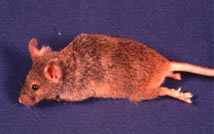
The ALS Association Uses Mouse Stem Cells to Find New Drugs
ALSA Renews Funding for Distribution of SOD1/G93A Rat for ALS Research
The ALS Association Funds Mouse Mutagenesis Project
ALSA-Initiated Grant to Fund SOD1 Screen for ALS Therapeutics
Modern techniques of molecular biology allow researchers to manipulate genes with unprecedented ease. Scientists can boost the production of protein coded by a gene, or silence it. Mutation of the SOD1 gene can produce many aspects of ALS. That allows researchers to build models of the disease by inserting that gene into animals that are easy to study in the lab. The mouse bearing the human gene for mutant SOD1 was the first lab model clearly linked to ALS based on a known cause of the disease. But other models are now available or being designed. All will undoubtedly enable rapid progress in finding new ways to approach ALS treatment.
 |
|
Mouse Model of ALS |
All models are merely tools, and each has certain advantages that lend power to the search for new ALS therapies. The SOD1 mouse is easily bred and housed in the lab. It has provided a large amount of data that other researchers can access. The newer rodent model, an ALS rat, also is engineered to express human mutant SOD1. The rat is larger and surgery is easier for applications such as stem cell transplants and other approaches that require injections into the spinal cord.
The worm and the fly models of ALS will be especially valuable as flies breed fast, and the worm has a basic and simple biology: it has 959 cells, and a three day life cycle. Genetics of both these creatures are known in great detail. The zebrafish model of ALS will also be a useful addition to the ALS research toolbox. Both the fish and the worm offer scientists the ability to actually watch what happens when proteins are changed by mutation, as the worm and the fish larvae both are transparent.
 |
|
fruit fly drosophila, the worm C. elegans, and zebrafish |
Even cells growing in a dish are desirable for ALS research. Cell based tests that reflect aspects of the disease process in ALS can rapidly report on the potential of new molecules to serve as therapeutics.
The ability of investigators to manipulate genes in animals that model human disease also leads to ways to ask, what other genes can influence the way a disease process appears or progresses. ALSA funded research is actively seeking other genes can influence the disease process in ALS.
